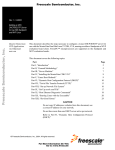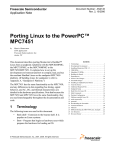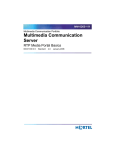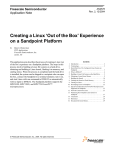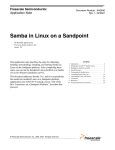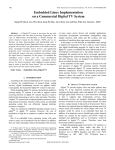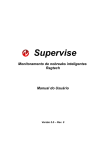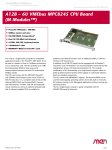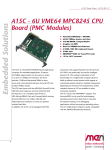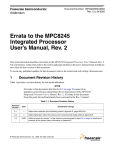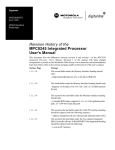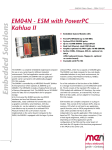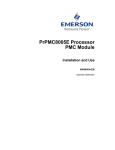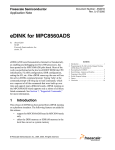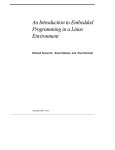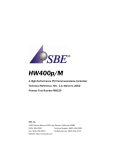Download AN2222:Porting Linux to the MPC8245
Transcript
Freescale Semiconductor, Inc. AN2222 Rev. 1, 11/2003 Freescale Semiconductor, Inc... Porting Linux ® to the MPC8245 Maurie Ommerman, CPD Applications [email protected] This document describes the actions necessary to configure the MontaVista R2.0 linux kernel linux-2.4.2_hhl20 for the MPC8245 integrated processor. Note that this application note should also apply to the MPC8241 integrated processor even though this has not been verified in the lab. This document covers the following topics: Section Section 1, “Introduction” Section 2, “Development Environment” Section 3, “Building the Kernel and the Boot Image” Section 4, “Making a Hard Drive Linux OS” Section 5, “Making a Ramdisk Linux OS” Section 6, “Sandpoint Setup” Section 7, “Starting Linux with the Executable” Section 8, “Installing a Network on the Linux Hard Drive” Section 9, “/dev Directory” Section 10, “Selected Linux files” Section 11, “Revision History” 1 Page 1 3 3 8 9 11 13 20 21 21 31 Introduction This document is organized by parts that explain the steps to build a Linux system for the MPC8245 on Sandpoint using the Montavista release R2.0 sources linux kernel 2.4.2. The steps are summarized below. • • • • Section 1, “Introduction,” gives an overview of the process and defines terminology used in this document. Section 2, “Development Environment,” discusses the development environment used to build the PPC Linux kernel. The development environment includes the compilers and other necessary utilities. Section 3, “Building the Kernel and the Boot Image,” discusses code corrections, configuring the build, making the dependencies, and generating a downloadable srecord and kernel image. This section shows all the configuration parameters. Section 4, “Making a Hard Drive Linux OS,” is optional section that discusses how to configure the Linux kernel for a hard drive and make a hard drive OS. © Freescale Semiconductor, Inc., 2004. All rights reserved. For More Information On This Product, Go to: www.freescale.com Freescale Semiconductor, Inc. Introduction • • • • Freescale Semiconductor, Inc... • • • Section 5, “Making a Ramdisk Linux OS,” is optional section that discusses how to configure the Linux kernel for a ramdisk image and make a ramdisk OS. Section 6, “Sandpoint Setup,” on an MPC8245 Sandpoint, discusses how to configure the Sandpoint switches. Section 7, “Starting Linux with the Executable,” discusses downloading the srecord image to a board using DINK32, and a sample splash screen. Section 8, “Installing a Network on the Linux Hard Drive,” discusses configuring a network interface for this kernel. Section 9, “/dev Directory,” discusses how to recover from destroying the /dev directory. Section 10, “Selected Linux files,” includes three hidden files in Linux. Section 11, “Revision History,” documents the evolution of changes in this document. 1.1 Terminology The following terms are used in this document. • • • • • • • • • • • • • • • • • Bash shell—Extension to the bourne shell. It is popular on Linux systems.Sometimes called, gnu Born Again Bourne Shell. This is the default shell for most Linux systems because Linux uses Gnu tools exclusively (because they are free). Boot—Program that begins at hardware reset which prepares the hardware for loading an OS. Bourne shell—Original shell for unix distributions. CDK—Cross development kit. Development tools for Intel- or Mac-based Linux machine to build PPC Linux objects. COP--Common On chip Processor is an interface for debugging and controlling the processor. DINK32—Small OS debugger for the Sandpoint evaluation board. ICE--In Circuit Emulator, a device that sits between the processor and it’s pins on a board, which allows the ICE to control and debug the processor. IDE—Integrated Device Electronics, which is the standard interface for many devices including hard drives, CD-ROM drives, and others. Kernel—Portion of the OS that interfaces the hardware to the software. Lineo and Lynx—Other companies that distribute Linux sources for embedded applications. Mandrake and Yellow Dog—Companies that distribute desktop Linux sources and solutions. They base their distributions on Red Hat. Montavista and Hard Hat Linux (hhl)—One of several companies that modifies and distributes Linux sources for embedded applications. OS—Operating system. Red Hat—One of several companies that uses the freely distributed desktop Linux sources and packages them for distribution. They developed the RPM, which has become a standard for Linux. Required files—All Linux distributions require a configuration file, (.config), that specifies the configuration of the kernel, such as network, IDE, scsi, and other options. The.config file can be built automatically from the make menuconfig command. Two other files are also required in a CDK, .hhl_cross_compile, which specifies the cross compiler executables, and .hhl_target_cpu, which specifies the target cpu. RPM—Red Hat package manager. Program to install and to maintain groups of Linux binary, libraries, documentation, and other Linux-style objects. srec or srecord—This is a file that depicts a binary object file in an ascii representation. DINK32 can download srec or binary files. See Appendix D in the DINK32 User’s Manual. Porting Linux ® to the MPC8245 For More Information On This Product, Go to: www.freescale.com Freescale Semiconductor, Inc. Development Environment • 2 User type—Root user has permissions to install rpms, modify, create, and delete all files in all directories, mount and unmount file systems, start and end processes, and generally do anything on a Linux system. Unfortunately, this makes it easy to destroy the Linux development system and render it useless. For that reason, login as a root user only for those activities that require root permissions, and revert to normal user for all other activities, including building the Linux kernel. Development Environment Two development platforms are available, the G4 Mac and the PC. The installation procedure is the same for both platforms with only the few exceptions discussed in this document. The process defined in this document was executed with a Mandrake™ Linux 7.0, a variant of Redhat Linux, on a PC (Pentium 166MHz). Freescale Semiconductor, Inc... To create a development machine, do one of the following: • • Install a Linux into a PC, we use the Mandrake distribution. Install LinuxPPC onto a G4-running Mac OS, we use the YellowDog distribution. 2.1 Required Host RPMs The following RPMs are required for this build. Normally, they are installed on your host system, however, if you encounter a problem during the build or in performing any of the steps in this document, you should ensure that these are installed or install them. You will find these packages on the Mandrake install CDROM in /mnt/cdrom/Mandrake/RPMS. On other distributions, these rpms will be in similarly named directories on the host install CDROM. • • • rpm -ihv genromfs-0.3-6mdk.i586.rpm rpm -ihv gzip-1.2.4-18mdk.i586.rpm rpm -ihv ncurses-devel-5-.0-7mdk.i586.rpm The versions noted above are correct at the time of the document, you may have newer versions of these rpms for your host system. You can use the command ls genromfs*.rpm, gzip*.rpm, and ncurses*.rpm for the exact version and name. 2.2 Required Target RPMs In order to build an srecord, you must use either objcopy or zsrec. zsrec is only available from Montavista and is included on the Montavista release in the /common/ directory of the CDROM. — rpm -ihv hhl-zsrec-1.05.i386.rpm objcopy does not work with the zImage created with this release of Montavista R2.0, because this zImage does not conform to the objcopy section headers. The next release of Montavista should correct this. 3 Building the Kernel and the Boot Image Obtain Montavista’s CDK V2.0 from their web site, www.mvista.com. Install the PPC Linux kernel. For a host system that is based on a processor that implements the PowerPCTM architecture such as a Macintosh, you will use the native gnu tool chain. For host systems not based on the PowerPC architecture, you will need to install the PPC gnu cross tool chain. In both cases, you need to produce a code kernel for the Porting Linux ® to the MPC8245 For More Information On This Product, Go to: www.freescale.com Freescale freescale Semiconductor, Inc. Building the Kernel and the Boot Image PowerPC architecture. Follow the instructions supplied with the Montavista distribution for the proper install. You want to install the 82xx kernel and tools. 3.1 Directory Locations Once installed, all the code and tools will reside starting in the directory, /opt. • • Freescale Semiconductor, Inc... • • /opt/hardhat/host — contains some important cross tools, specifically, zsrec, which converts elf files into srecord files. /opt/hardhat/devkit/ppc/82xx/bin — contains all the cross compiler tool chain for systems not based on the PowerPC architecture. /opt/hardhat/devkit/ppc/82xx/target — contain a linux target system that can be used to build a Linux hard drive, see 4, “Making a Hard Drive Linux OS”. /opt/hardhat/devkit/lsp — contains all the kernel code for specific architectures. You want the freescale-sandpoint distribution. Specifically, you will find this distribution at /opt/hardhat/devkit/lsp/freescale-sandpoint/linux-2.4.2_hhl20. /opt is owned by root and therefore you must have root permission to make any changes to these directories The Makefiles are designed to find and use all the tools in these directories. The kernel distribution, /opt/hardhat/devkit/lsp/freescale-sandpoint/linux-2.4.2_hhl20, however, is not designed for execution and building in place. Instead, you must copy this kernel distribution from this location to a directory that is owned by a user. Thus, as a normal user, you will not need root permission for any of the steps in 3, “Building the Kernel and the Boot Image,” copy the kernel distribution to your own directory. You should give it a unique name, we used, MV2.0_8245_sandpoint. There are sym links in this directory, so a standard copy will not work correctly. Use the following sequence to create this new kernel directory. 3.2 Creating the Kernel Source Directories The bash shell is the default shell on the Mandrake and YellowDog distributions and is therefore recommended for use. In the /home/<name>/.bashrc file add the following line: PATH=$PATH:/opt/hardhat/devkit/ppc/82xx/bin:/opt/hardhat/host/bin The CDK kernel source is found at the following directory: • /opt/hardhat/devkit/lsp/freesale-sandpoint/linux-2.4.2_hhl20/ It is required that this directory should be tarred and moved to a local user directory for modifying and building the MPC8245 version. In this way, if a significant mistake is made, work can be begun again from the tar. Also, and perhaps a more important reason, the Linux kernel should be built as a normal user. cd /opt/hardhat/devkit/lsp/-sandpoint tar -cvf ~/MV2.0_8245_sandpoint/linux_sp.tar * cd ~/MV2.0_8245_sandpoint tar -xvf linux_sp.tar Porting Linux ® to the MPC8245 For More Information On This Product, Go to: www.freescale.com Freescale Semiconductor, Inc. Building the Kernel and the Boot Image 3.3 Changes to the Kernel Source Distribution The standard distribution is designed for the MPC8240 and Tundra Tsi107™ PowerPC host bridge style configurations. For the MPC8245 distribution, you must make the following changes. • • Freescale Semiconductor, Inc... • Change to the ~/MV2.0_8245_sandpoint/linux-2.4.2_hhl20/arch/ppc/kernel directory. Edit the mpc10x.h file. — add the following line #define MPC10X_BRIDGE_8245 ((0x0006 << 16) | PCI_VENDOR_ID_FREESCALE) to the file. You may search for this line and add the above line below it. #define MPC10X_BRIDGE_8240 ((0x0003 << 16) | PCI_VENDOR_ID_FREESCALE) Edit the mpc10x_common.c file. — add the following line case MPC10X_BRIDGE_8245 to the file. You should search for this line and add the above line below it. case MPC10X_BRIDGE_8240: 3.4 Configuring the Linux Image There are three commands for setting the configuration and creating a .config file. 1. make menuconfig (recommended because it is interactive) — We use this one in this document. NOTE: To make menuconfig requires that ncurses-devel-5.0-7mdk.i586.rpm is installed from the Mandrake CD. This is normally installed but if it is not then, install this rpm. See Section 2.1, “Required Host RPMs”. 2. make config (not recommended) 3. make oldconfig — We use this for our hard drive configuration, see Section 3.5.1, “Make Changes to the .config File”. 3.4.1 make menuconfig During the menuconfig phase, there are many options for configuring the kernel being built, which are discussed below. Enter these interactive commands: • • enter or space—Select (or go into submenu) esc—Return to previous menu Before you can run menuconfig, you need to ensure that these two hidden files exist and are correct in your ~/MV2.0_8245_sandpoint/linux-2.4.2_hhl20 directory. If not, then create and/or correct them. • • .hhl_cross_compile — /opt/hardhat/devkit/ppc/82xx/bin/ppc_82xx.hhl_target_cpu — ppc Porting Linux ® to the MPC8245 For More Information On This Product, Go to: www.freescale.com Freescale Semiconductor, Inc. Building the Kernel and the Boot Image Invoke the menu configuration, which will update your hidden file, .config make menuconfig. • Freescale Semiconductor, Inc... • • • Choose Platform Support — ensure that (6xx/7xx/74xx/82xx) Processor Type is set and all other options under this choice are turned off, including AltiVec Support. If you are using network support, which is included by default, you will need to specify your NIC card, see Section 8, “Installing a Network on the Linux Hard Drive.” — network device support ----> — Ethernet (10 or 100 Mbits) ---> — choose your NIC card – we chose, RealTek RTL-8139 PCI Fast Ethernet Adapter support — networking options – turn off BOOTP, the default is on. You need to determine what type of IP support is at your site, in our case we do not use BOOTP. If BOOTP is selected and there is no BOOTP support, you will have to wait until linux discovers that there is no support (several minutes) and then it will continue booting. All the other choices should be correct, however, the .config file is listed at the end of this document. You may compare it to your .config file. Exit menuconfig 3.5 Hard Drive Boot If you are using a hard drive for your system, see Section 4, “Making a Hard Drive Linux OS,” then you will need to make the following changes to your .config file. 3.5.1 Make Changes to the .config File Change # CONFIG_CMDLINE_BOOL is not set To CONFIG_CMDLINE_BOOL=y CONFIG_CMDLINE="root=/dev/hdb1" This is the configuration we use in this document. 3.5.2 Incorporate the Changes make oldconfig 3.6 Dependencies The make dep builds all the dependencies of all the source files for the build.The makefiles use these dependency files in place of the normal make dependency rules. Therefore, it is important to do a Porting Linux ® to the MPC8245 For More Information On This Product, Go to: www.freescale.com Freescale Semiconductor, Inc. Building the Kernel and the Boot Image make dep whenever any dependencies or configurations are changed. If it is necessary to make extensive changes to a dependency file that has been previously set up, first remove the two dependency files below. • • .depend .hdepend 3.6.1 Make the Dependencies make dep 3.7 Executable Images Freescale Semiconductor, Inc... These commands are used in building the images. • make zImage — To build an image that uses a hard disk see 4, “Making a Hard Drive Linux OS”. • make zImage.initrd — To build an image that uses a ramdisk see 5, “Making a Ramdisk Linux OS” The sequence of the build that make performs is as follows: 1. Creates an elf file called vmlinux. 2. Compiles the bootloader (also an elf file) 3. Combines the bootloader and vmlinux to create /linux/arch/ppc/boot/images/zImage.sandpoint 3.7.1 Kernel-Executable Elf File Load the file zImage.sandpoint into the Sandpoint RAM. This can be loaded directly into memory at address 900000 via a COP or ICE. We, however, use an srecord loader. 3.7.2 Freescale Srecord File Now that the elf file is made, a Freescale Srecord can be created that can be downloaded to the board using DINK32. 3.7.2.1 Recommended Method /opt/hardhat/host/bin/zsrec -s 900000 arch/ppc/boot/images/zImage.sandpoint >vm.src If zsrec is not found then see step 4 in Section 2.1, “Required Host RPMs.” 3.7.2.2 Alternative Method (Do not use with MV2.0) • cp arch/ppc/boot/images/zImage.sandpoint vm.src copies the elf file to the ~/MV2.0_8245_sandpoint/linux-2.4.2_hhl20. NOTE: objcopy does not work with this release The command shown below, objcopy, does not work with the zImage created with this release of Montavista R2.0 because it does not conform to the objcopy section headers. The next release of Montavista should correct this problem. Porting Linux ® to the MPC8245 For More Information On This Product, Go to: www.freescale.com Freescale Semiconductor, Inc. Making a Hard Drive Linux OS • 4 ppc_82xx-objcopy -O srec vm.src converts the elf file in place to an srecord. Making a Hard Drive Linux OS 4.1 Hard Drive for Linux OS The downloadable image file recently built by the make zImage requires a hard drive on the primary IDE channel of the Sandpoint. You must be root user to perform these commands. Freescale Semiconductor, Inc... To make this hard drive use either the PC or Mac Linux development system. Physically connect a hard drive to the development system on an IDE channel. Note that it is necessary to be root to perform these steps. In Linux, the command fdisk can be used to format and create an 'ext2' filesystem on the hard drive. For the configuration modifications described in Section 3.5, “Hard Drive Boot,” name it hdb1. It must be the first partition on this disk and it must be an IDE disk. fdisk must have an argument of one of the following disk drive addresses: /dev/hda for master IDE /dev/hdb for slave IDE /dev/sda for first scsi drive /dev/sdb for second scsi drive And so on. For example, the resulting command fdisk /dev/hdb starts fdisk on the slave IDE drive. 4.2 fdisk Commands To create the partition using fdisk execute the following sequence: 1. p—Prints the partition list. It ensures a disk was not chosen that should be kept. If the wrong disk is chosen, use the command q to quit with no changes. 2. d—Deletes all partitions on this disk. (If there are no partitions, skip this step.) 3. n—Adds a new partition. Follow the steps on the screen, create partition 1 with all the space available on the device. 4. p—Ensures set up is correct. Note that Step 5 or 6 should be chosen, but not both. 5. q—At this point, the q command can be given without changing the partition. Using this option ignores any changes and the disk retains its previous partition table. 6. w—Writes the new partition. At this point changes are permanent and the old partition cannot be retrieved. Porting Linux ® to the MPC8245 For More Information On This Product, Go to: www.freescale.com Freescale Semiconductor, Inc. Making a Ramdisk Linux OS 4.3 Partition Configuration 4.3.1 Creating a New Partition mke2fs builds a Linux file system on a specified disk if the disk does not already have one. Therefore, choosing the wrong partition, that is, one with any filesystem already on it, results in an error. Specify a partition for mke2fs (unlike fdisk which must specify an entire disk, e.g. /dev/hda). For example, mke2fs /dev/hdb1 creates a file system on the first partition on the slave IDE drive. 4.3.2 Mounting the Partition Freescale Semiconductor, Inc... Execute the following commands to mount the new partition: cd / mkdir newdisk (makes a directory to mount the partition) mount /dev/hdb1 newdisk (partition is now usable as if it were a normal directory) 4.3.3 Creating Linux OS on the Partition 1. Tar the contents of the /opt/hardhat/devkit/ppc/82xx/target directory. In that directory type: tar cvf filesystem.tar * 2. Untar the filesystem.tar file onto the root directory of the newly created hard drive. cd /newdisk tar xvf /opt/hardhat/devkit/ppc/82xx/target/filesystem.tar 3. Unmount the hard drive and shutdown the Linux system. 4. Physically remove the newly-created hard drive. 5. Physically install it into the Sandpoint on IDE0. NOTE Regardless of whether this was created as /dev/hda or /dev/hdb, it can be physically connected to the Sandpoint as the master or slave IDE0, which is /dev/hda. The boot partition should be /dev/hda1 for the master or /dev/hdb1 for the slave. Since the configuration, .config, was modified to expect /dev/hdb1, connect it as slave IDE0. See 3.5, “Hard Drive Boot”. However, by changing the boot partition at startup, when Linux/PPC Load root=/dev/hdb1 appears, it can be changed to something else, such as root=/dev/hdb2. In this case, the disk would be set up as IDE0 slave and the second partition on the disk would contain the Linux file system. 5 Making a Ramdisk Linux OS Even this procedure was followed for a previous build, as described in application notes AN2145/D, it has not been retested for this MPC8245 build. It is copied here for your convenience if you wish to use a ramdisk instead of the hard drive approach above. To make a ram drive (ramdisk) for the Sandpoint Linux system use the make zImage.initrd command and follow the steps outlined in the subsequent sections. Porting Linux ® to the MPC8245 For More Information On This Product, Go to: www.freescale.com Freescale Semiconductor, Inc. Making a Ramdisk Linux OS During make menuconfig (see Section 3.4, “Configuring the Linux Image”), turn off network device support and ATA/IDE support. 5.1 make menuconfig In the top level of the menu during make menuconfig (see Section 3.4, “Configuring the Linux Image”), select and turn off: • • Network Device Support ATA/IDE/MFM/RLL support In top level of the menu select and turn on: Freescale Semiconductor, Inc... • • File systems Rom file system Support Block Devices Ram disk support 5.2 genromfs genromfs works similarly to tar, creating an image given a target directory. The target directory should create a file ramdisk.img that can be mounted as a device. 5.2.1 Creating the ramdisk Image 1. Download a sample ramdisk image from the following site: http://altus.drgw.net/results/ 2. Unzip it with the following command: gzip -d ramdisk.img.gz 5.2.2 Mounting the ramdisk Image 1. 2. 3. 4. 5. 6. 7. 8. 9. 10. Create a directory called ramdisk in the /mnt directory. Mount the image file with the following command: mount -o loop ramdisk.img /mnt/ramdisk View the contents of the image with the ls command. Create a new directory called myRomFS anywhere (not on the mounted ramdisk) and make the normal /bin, /dev, etc... directories underneath Using the sample ramdisk.img as a starting point, add and remove files depending on what the romfs will need. The goal is to keep this as small as possible, as each file adds to the already long download time. Test programs can also be included. Copy all the directories from the downloaded ramdisk to this new one with the following commands. Note the -a is necessary for the dev directory and includes recursive activity. cp -a /mnt/ramdisk myRomFS On startup, Linux looks for a startup script called linuxrc in the root directory. The linuxrc file in root of this ramdisk is symlinked to a file called /bin/run. Instead of this, your linuxrc should symlink to the file /bin/ash, which will bring up a simple command shell. Test it to determine that all the necessary files to run the tests exist, using the command chroot. The command should look like this: Porting Linux ® to the MPC8245 For More Information On This Product, Go to: www.freescale.com Freescale Semiconductor, Inc. Sandpoint Setup 11. chroot myRomFS ash (note: there may be a dash before the ash). 12. This makes every subsequent command treat the new directory as the root. Now run the tests to see whether they run correctly or not. 13. Once the myRomFS directory has been filled with the necessary files, create the ramdisk.img using genromfs. 14. genromfs -d myRomFS -f ramdisk.image 15. Compress this file using the command line: gzip ramdisk.image Freescale Semiconductor, Inc... This should create the file ramdisk.image.gz. 16. Place this file into the /arch/ppc/boot directory. It must be named ramdisk.image.gz. 17. Make the new binary with the command make zimage.initrd 18. This creates a file called zvmlinux.initrd which is the kernel and the ramdisk. This can now be converted to an srec and downloaded to the MPC8245 PMC with DINK32's dl -k command (see 7.1, “Downloading the Executable”) It should bring up a command prompt. 19. Change the Linux prompt — boot=/dev/hdb1, to the following: boot=/dev/ram ramdisk=8192 (or whatever the ramdisk size may be; default is 4096) 20. The ramdisk size is set in the source code in drivers/block/rd.c to what ever size is desired. However, this has changed from MV1.2 to MV2.0, and I have not determined the exact change necessary. It may be automatic. 5.2.3 References For a brief introduction to Romfs refer to this site: www.linuxhq.com/kernel/v2.2/doc/filesystems/romfs.txt.html For information on different ways to implement embedded File Systems on systems based on the PowerPC architecture, refer to this site: www.members.nbci.com/greyhams/linux/PowerPC-Embedded-HOWTO -12.html For an introduction to loopback devices (virtual devices like the ramdisk image), refer to this site: www.linuxdoc.org/HOWTO/mini/Loopback-Root-FS-2.html 6 Sandpoint Setup Before the Linux kernel download file can be used, the Sandpoint Platform needs to be setup. 6.1 Sandpoint X2 Sandpoint X2 requires the following switch configuration: • S3:S4 - Mode 1, PMC W/Slots — S3: toward PMC Porting Linux ® to the MPC8245 For More Information On This Product, Go to: www.freescale.com Freescale Semiconductor, Inc. Sandpoint Setup • — S4: away from PMC S5 - Interrupt to PMC Normal — S5: toward PMC NOTE The S5 switch controls interrupts. If this switch is set in the wrong direction, then linux will hang on this part of the boot sequence. OpenPIC Version 1.2 (1 CPUs and 24 IRQ sources) at f7fd0000 Freescale Semiconductor, Inc... Moving the switch to the opposite position will dynamically change the board and linux will continue with it's boot.So, if it hangs in one position, change the position and it should continue the boot. • S6 - Local I/O shared with Slot 2 — S6: toward PMC 6.2 Sandpoint X3 Although the interrupt scheme is significantly different between the two versions of Sandpoint, there is a way to select the Sandpoint X2 interrupt scheme on the Sandpoint X3, which is required for this port to the MP8245. The Sandpoint X3 can be placed into legacy mode and the interrupts will work the same as on the Sandpoint X2. The sections below explain this procedure. For more information, refer to the Sandpoint 3 manual, which comes with the board and is also available on the freescale web site. 6.2.1 Legacy Mode Enable Sequence Orientation of the switches is with the Sandpoint PMC located in the upper left corner, which corresponds to the diagram of the motherboard in the Sandpoint X3 User’s Manual. • • SW2 — position 3, move to the left (off) – select the legacy interrupt connections desired, we use the following — all the other positions, 1,2,4,5,6,7,8 to the right (on). SW1 — position 1,2,3,4,5 to the right (on) — position 6,7,8 to the left (off) 6.2.1.1 Refer to the Sandpoint X3 User’s Manual for the following information • • • • Location of SW1 - page 6 Location of SW2 - page 6 Description of Ilegacy mode - page 10 Description of interrupt Legacy modes - page 12 Porting Linux ® to the MPC8245 For More Information On This Product, Go to: www.freescale.com Freescale Semiconductor, Inc. Starting Linux with the Executable 7 Starting Linux with the Executable 7.1 Downloading the Executable Freescale Semiconductor, Inc... There are two methods for downloading the executable using DINK32. They are as follows: 1. Using the traditional ascii srecord form, run DINK32 from any terminal emulator. Download the previously created srecord using DINK32 (it is about 20000 lines and takes about 5 minutes, at 38400 baud to download). — Use these DINK32 commands: sb -k 38400 dl -k (start the download file utility) — When download is complete: go 900000 – The default Linux kernel runs at 9600 baud rate so it may be necessary to change the baud rate to 9600 with this command: sb -k 9600 However, if changes were made in the baud rate (not described in this document) the kernel can run at 38400 and this command is not needed. 2. Using the faster binary srecord form: — Obtain the srec2bin executable from the DINK32 distribution at dink32/demos/utilities/srec2bin. DINK32 is available on the freescale web. — Build the executable with the make command on your host system. — Copy the executable, srec2bin, to the /bin directory or invoke srec2bin directly. — Run the command srec2bin < file.src > file.bin — Download it with the command in DINK32: sb -k 38400 l -b -o 900000 — When download is complete, type: go 900000 The default Linux kernel runs at 9600 baud rate so it may be necessary to change the baud rate to 9600 with this command: sb -k 9600 However, the kernel can be changed to set the default baud rate to 38400 and then this command would not be needed. 7.2 Terminal Emulators Use any terminal emulator on NT or UNIX and execute the following sequence: 1. On WinNT or Win9x use hyperterminal. To download, — Type the command dl -k or dl -b -o 900000 (see Section 2., “Using the faster binary srecord form:) — Use the menu item, transfer | send text file (do not use the 'send file' option) Set 0 character delay Porting Linux ® to the MPC8245 For More Information On This Product, Go to: www.freescale.com Freescale Semiconductor, Inc. Starting Linux with the Executable 2. Linux uses the standard terminal emulator minicom if it is available. Note that the serial port is /dev/ttyS0. — Use mincom download. This requires setting up a user transfer protocol (see Section 7.4, “Using Minicom”). This method is not recommended. — Use a separate window to initiate a transfer of the file – In minicom, type: dl -k or dl -b -o 900000 – In another terminal window, to start the download, type cat vm.src > /dev/ttyS0 (see Section 7.3, “Minicom”) Freescale Semiconductor, Inc... 7.3 Minicom This is a short discussion of how to use minicom on a Linux system. The Linux development system and minicom are used to communicate with the Linux Sandpoint target. Minicom can only be used by a root user to set up the configuration, to execute minicom, and to use the /dev/ttyS0 facility. Thus to run minicomn, it is necessary to be root. 7.4 Using Minicom To start minicom in configuration mode to set the terminal characteristics such as baud rate, type: minicom -s To start minicom in terminal mode, type: minicom To configure minicom while its running, type: control-A To create file transfer protocols, type: Z O choose file transfer protocols set up this protocol: ascii2 /usr/bin/ascii-xfr -svu -l 15 Y U N Y N and use it for downloads e.g. dl -k esc to go to previous menus To change the baud rate, type: control-A Z O choose serial port setup E to change the baud rate esc to go to previous menus To exit minicom, type: control-A x Porting Linux ® to the MPC8245 For More Information On This Product, Go to: www.freescale.com Freescale Semiconductor, Inc. Starting Linux with the Executable 7.4.1 Minicom Problems When trying to start minicom these errors may occur. • • Minicom: cannot open /dev/ttyS0: Permission denied — Remember that only as root can one run minicom Terminal /dev/ttyS0 is busy — This indicates that some other process has attached ttyS0 and it must be terminated before minicom can start. It is necessary to be root to perform these actions. Type: ps -ef | grep minicom — Close the other minicom process, even if the terminal window is already closed, by typing "kill -9 <minicom process number> Freescale Semiconductor, Inc... • Can’t find /dev/modem — This indicates that the configuration file, df1, is either missing or setup incorrectly. Type: minicom -s — Choose the serial port setup Change A. Serial Device: /dev/modem to /dev/ttyS0 esc (escape key) Choose save setup as df1 Then choose exit 7.5 DINK32 Booting a MPC8245 Linux: Example This example uses the code built according to the instructions in this document. 7.6 Downloading 7.6.1 Windows NT version • • • sb -k 38400 — set the emulator baud rate to 38400 dl -k or dl -k -o 900000 is issued in the WinNT emulator window The file is downloaded as ascii text or binary 7.6.2 Linux minicom version Linux uses a 9600 default baud rate; DINK32 binary srecord download feature was used. • • • sb -k 38400 — set the minicom baud rate to 38400 dl -k or dl -b -o 900000 is issued in the minicom emulator window the command cat vm1.src (or vm1.bin) > /dev/ttyS0 is issued in another terminal window. 7.7 Starting Linux • sb -k 9600 — change baud rate back to 9600 Porting Linux ® to the MPC8245 For More Information On This Product, Go to: www.freescale.com Freescale Semiconductor, Inc. Starting Linux with the Executable • go 90000 7.8 Splash Screen The splash screen is shown below. NFS was enabled during configuration, the Realtek 8139 ethernet card was specified, and BOOTP was disabled. Baud rate changing to 38400... Memory Enabled: [ 64MB at CL=3 ] Caches Enabled: [ L1-ICache L1-DCache ] Freescale Semiconductor, Inc... Register Inits: [ 32 GPRs, 32 FPRs, 155 SPRs ] Assembler Init: [ 895 opcodes ] ###### ### # # # # ##### ##### # # # ## ## # # # # # ## ### # # # # # # ## # # # # #### ## # # # # ## # # # ##### ##### ## # # # ###### ### # ## # # # ##### ####### Version : XX.X, Metaware Build Released : Interim Release: Built on Jan 7 2002 21:26:05 Written by : Motorola's RISC Applications Group, Austin, TX System : Sandpoint X3 with Unity (MPMC8245) Processor : MPC8245 V1.1 @ 200 MHz, Memory @ 100 MHz Memory : Map B (CHRP) 64MB at 3/1/1/1 Copyright Inc. 1993-2001 Refer to `history.c' for release info, changes, errata and fixes. DINK32[MPC8245] {1} >>dl -k Download from Keyboard Port Porting Linux ® to the MPC8245 For More Information On This Product, Go to: www.freescale.com Freescale Semiconductor, Inc. Starting Linux with the Executable 19752 lines received. Download complete. DINK32[MPC8245] {2} >>sb -k 9600 DINK32[MPC8245] {3} >> DINK32[MPC8245] {3} >> DINK32[MPC8245] {3} >>go 900000 loaded at: 00900000 009091B8 Freescale Semiconductor, Inc... relocated to: 00800000 008091B8 zimage at: 00906000 00998FA9 avail ram: 00400000 00800000 Linux/PPC load: root=/dev/hdb1 Uncompressing Linux...done. Now booting the kernel Total memory = 32MB; using 128kB for hash table (at c01a0000) Linux version 2.4.2_hhl20 (maurie@appslab1) (gcc version 2.95.3 20010315 (releas e/MontaVista)) #4 Tue Jan 8 08:23:12 MST 2002 Freescale SPS Sandpoint Test Platform Sandpoint port (C) 2000, 2001 MontaVista Software, Inc. ([email protected]) On node 0 totalpages: 8192 zone(0): 8192 pages. zone(1): 0 pages. zone(2): 0 pages. Kernel command line: root=/dev/hdb1 OpenPIC Version 1.2 (1 CPUs and 26 IRQ sources) at f7fd0000 OpenPIC timer frequency is 100.000000 MHz time_init: decrementer frequency = 24.753105 MHz Calibrating delay loop... 131.89 BogoMIPS Memory: 30440k available (1048k kernel code, 468k data, 84k init, 0k highmem) Dentry-cache hash table entries: 4096 (order: 3, 32768 bytes) Buffer-cache hash table entries: 1024 (order: 0, 4096 bytes) Page-cache hash table entries: 8192 (order: 3, 32768 bytes) Inode-cache hash table entries: 2048 (order: 2, 16384 bytes) Porting Linux ® to the MPC8245 For More Information On This Product, Go to: www.freescale.com Freescale Semiconductor, Inc. Starting Linux with the Executable POSIX conformance testing by UNIFIX PCI: Probing PCI hardware Linux NET4.0 for Linux 2.4 Based upon Swansea University Computer Society NET3.039 Starting kswapd v1.8 pty: 256 Unix98 ptys configured block: queued sectors max/low 20152kB/6717kB, 64 slots per queue RAMDISK driver initialized: 16 RAM disks of 4096K size 1024 blocksize Freescale Semiconductor, Inc... Uniform Multi-Platform E-IDE driver Revision: 6.31 ide: Assuming 33MHz system bus speed for PIO modes; override with idebus=xx W82C105: IDE controller on PCI bus 00 dev 59 W82C105: chipset revision 5 W82C105: 100% native mode on irq 17 ide0: BM-DMA at 0xbfffd0-0xbfffd7, BIOS settings: hda:pio, hdb:pio SL82C105 command word: 5 IDE timing: 00000909, resetting to PIO0 timing ide1: BM-DMA at 0xbfffd8-0xbfffdf, BIOS settings: hdc:pio, hdd:pio SL82C105 command word: 5 IDE timing: 000003e4, resetting to PIO0 timing hdb: ST310210A, ATA DISK drive ide0 at 0xbffff8-0xbfffff,0xbffff6 on irq 14 hdb: 19925880 sectors (10202 MB) w/2048KiB Cache, CHS=19767/16/63 Partition check: hdb: hdb1 loop: loaded (max 8 devices) Serial driver version 5.02 (2000-08-09) with MANY_PORTS SHARE_IRQ SERIAL_PCI ena bled ttyS00 at 0x03f8 (irq = 4) is a 16550A ttyS01 at 0x02f8 (irq = 3) is a 16550A 8139too Fast Ethernet driver 0.9.13 loaded eth0: RealTek RTL8139 Fast Ethernet at 0xbfffff00, 00:40:c7:87:50:b2, IRQ 18 NET4: Linux TCP/IP 1.0 for NET4.0 IP Protocols: ICMP, UDP, TCP IP: routing cache hash table of 512 buckets, 4Kbytes Porting Linux ® to the MPC8245 For More Information On This Product, Go to: www.freescale.com Freescale Semiconductor, Inc. Starting Linux with the Executable TCP: Hash tables configured (established 2048 bind 2048) IP-Config: Incomplete network configuration information. NET4: Unix domain sockets 1.0/SMP for Linux NET4.0. VFS: Mounted root (ext2 filesystem) readonly. Freeing unused kernel memory: 84k init 4k openfirmware INIT: version 2.77 booting EXT2-fs warning: mounting unchecked fs, running e2fsck is recommended INIT: Entering runlevel: 3 Freescale Semiconductor, Inc... sh-2.03# Starting the network from /etc/rc.d/rc. eth0: Setting full-duplex based on MII #32 link partner ability of 41e1. sh-2.03# ifconfig eth0 Link encap:Ethernet HWaddr 00:40:C7:87:50:B2 inet addr:163.11.104.163 Bcast:163.11.255.255 Mask:255.255.255.0 UP BROADCAST RUNNING MULTICAST MTU:1500 Metric:1 RX packets:4 errors:0 dropped:0 overruns:0 frame:0 TX packets:0 errors:0 dropped:0 overruns:0 carrier:0 collisions:0 txqueuelen:100 Interrupt:18 Base address:0xff00 lo Link encap:Local Loopback inet addr:127.0.0.1 Mask:255.0.0.0 UP LOOPBACK RUNNING MTU:3904 Metric:1 RX packets:0 errors:0 dropped:0 overruns:0 frame:0 TX packets:0 errors:0 dropped:0 overruns:0 carrier:0 collisions:0 txqueuelen:0 sh-2.03# ls bin dink32.src hdparm lib boot dink32.src2 home dev etc man proc libexec sbin tmp web mnt readme_mount.txt share usr include lost+found opt root test var sh-2.03# df Filesystem 1k-blocks Used Available Use% Mounted on sh-2.03# mkdir mounted_drive Porting Linux ® to the MPC8245 For More Information On This Product, Go to: www.freescale.com Freescale Semiconductor, Inc. Installing a Network on the Linux Hard Drive sh-2.03# mount /dev/hdb1 mounted_drive sh-2.03# cd mounted_drive sh-2.03# ls bin etc libexec opt boot hdparm lost+found dev home man dink32.src include mnt dink32.src2 lib share web proc test readme_mount.txt tmp root mounted_drive sbin usr var Freescale Semiconductor, Inc... sh-2.03# df Filesystem 1k-blocks /dev/hdb1 9804840 Used Available Use% Mounted on 245176 9061540 3% /mounted_drive sh-2.03# ping 163.11.105.60 PING 163.11.105.60 (163.11.105.60): 56 data bytes 8 Installing a Network on the Linux Hard Drive Use the following list of instructions to add network capability to the standard montavista harddrive target on sandpoint linux. 1. Build standard hard drive, see 4, “Making a Hard Drive Linux OS”. 2. make menuconfig — turn on nfs, turn off BOOTP, turn on driver, in our case the Realtek 6139 driver 3. make the srecord of zImage. 4. boot linux via dink32. 5. bring up the network interface on sandpoint (optional) — execute command: /sbin/ifconfig eth0 <x.x.x.x> netmask x.x.x.x netmask's go with ip addresses — example of subnet 104 : /sbin/ifconfig eth0 163.11.104.163 netmask 255.255.255.0 this will bring up the network interface. It is now possible to do ftp and other network activity. 6. Build the rc file and modify the inittab for a permanent change to start the network on boot. (It is not necessary to do step 5 above for this to work) — a. cd /etc/rc.d — b. cut-n-paste the following lines into the terminal window: choose a correct IP address and netmask for your location! echo "#"\!"/bin/sh" >> rc Porting Linux ® to the MPC8245 For More Information On This Product, Go to: www.freescale.com Freescale Semiconductor, Inc. /dev Directory echo "# absolute bare-bones network config" >> rc echo "echo \"Starting the network from /etc/rc.d/rc.\"" >> rc echo "/sbin/ifconfig eth0 163.11.104.163 netmask 255.255.255.0" >> rc echo "route add -net 0.0.0.0/0 gw 163.11.104.254" >> rc Freescale Semiconductor, Inc... — c. cat rc (to ensure it is correct) — d. chmod 755 rc — e. uncomment the following line in /etc/inittab (~ line #34): #l3:3:wait:/etc/rc.d/rc 3 — f. reboot by using the command "init 0" or "shutdown -h now". 9 /dev Directory 9.1 What if I Kill the /dev Directory? The /dev directory contains all the device resources for the system. Every device, CDROM, disk partition, terminal, window, and so on are named /dev/<device name> and contained in the /dev directory. These are not file names; they are device names. During the work with the Linux OS, it may be desired to remove some devices and add others. If all the devices in the /dev directory were accidently removed on the target system, there are two options: repair it or rebuild it on the development system. If this occurs on the development system, there are also two options: repair it or reinstall the Linux system. In all cases try repair number 1 first, then if that fails, try 2 or 3. 1. Repair /dev for the development system on the development system. Don't kill the terminal window: it is not possible to start a new one. If you do, it will be necessary to reinstall Linux (using 3 below), because each terminal window is a device and no more windows may be started. Therefore, while in the same window used to accidently kill /dev and while in the /dev directory, run the script MAKEDEV. This will recreate the /dev devices. 2. Rebuild /dev for the target Sandpoint system on the development system. For the hard drive, follow the instructions in 4.1, “Hard Drive for Linux OS” and recopy the /dev directory. For the ramdisk, follow the instructions in Section 5, “Making a Ramdisk Linux OS”. Unfortunately, it is not as simple as recopying the /dev directory because a ramdisk is a compressed file. Therefore, recreate the entire ramdisk file. 3. Reinstall Linux on the development system, which usually requires formatting the main partition and reinstalling Linux and any packages that may have been destroyed. 10 Selected Linux files 10.1 .hhl_cross_compile /opt/hardhat/devkit/ppc/82xx/bin/ppc_82xx- Porting Linux ® to the MPC8245 For More Information On This Product, Go to: www.freescale.com Freescale Semiconductor, Inc. Selected Linux files 10.2 .hhl_target_cpu ppc 10.3 .config Freescale Semiconductor, Inc... # # Automatically generated by make menuconfig: don't edit # # CONFIG_UID16 is not set # # Code maturity level options # CONFIG_EXPERIMENTAL=y # # Loadable module support # CONFIG_MODULES=y # CONFIG_MODVERSIONS is not set CONFIG_KMOD=y # # Platform support # CONFIG_PPC=y CONFIG_6xx=y # CONFIG_4xx is not set # CONFIG_POWER3 is not set # CONFIG_POWER4 is not set # CONFIG_8xx is not set # CONFIG_8260 is not set # CONFIG_WORKSTATION_PPC is not set # CONFIG_APUS is not set # CONFIG_PMPPC is not set # CONFIG_PCORE is not set # CONFIG_FC710 is not set # CONFIG_SPRUCE is not set # CONFIG_MENF1 is not set # CONFIG_MCPN765 is not set # CONFIG_MVME5100 is not set # CONFIG_PRPMC750 is not set # CONFIG_PRPMC800 is not set CONFIG_SANDPOINT=y # CONFIG_BS420 is not set # CONFIG_K2 is not set # CONFIG_GEMINI is not set # CONFIG_ZX4500 is not set # CONFIG_MPC10X_STORE_GATHERING is not set # CONFIG_PPC601_SYNC_FIX is not set # CONFIG_SMP is not set # CONFIG_ALTIVEC is not set Porting Linux ® to the MPC8245 For More Information On This Product, Go to: www.freescale.com Freescale Semiconductor, Inc. Selected Linux files Freescale Semiconductor, Inc... # CONFIG_TAU is not set # CONFIG_OPENFIRMWARE is not set # CONFIG_RTSCHED is not set # # General setup # # CONFIG_HIGHMEM is not set # CONFIG_MOL is not set # CONFIG_ISA is not set # CONFIG_EISA is not set # CONFIG_SBUS is not set # CONFIG_MCA is not set CONFIG_PCI=y CONFIG_NET=y CONFIG_SYSCTL=y CONFIG_SYSVIPC=y # CONFIG_BSD_PROCESS_ACCT is not set CONFIG_KCORE_ELF=y CONFIG_BINFMT_ELF=y CONFIG_KERNEL_ELF=y CONFIG_BINFMT_MISC=y # CONFIG_PCI_NAMES is not set # CONFIG_HOTPLUG is not set # CONFIG_PCMCIA is not set # # Parallel port support # # CONFIG_PARPORT is not set CONFIG_PPC_RTC=y CONFIG_CMDLINE_BOOL=y CONFIG_CMDLINE="root=/dev/hdb1" # # Memory Technology Devices (MTD) # # CONFIG_MTD is not set # # Plug and Play configuration # # CONFIG_PNP is not set # CONFIG_ISAPNP is not set # # Block devices # # CONFIG_BLK_DEV_FD is not set # CONFIG_BLK_DEV_XD is not set # CONFIG_PARIDE is not set # CONFIG_BLK_CPQ_DA is not set # CONFIG_BLK_CPQ_CISS_DA is not set Porting Linux ® to the MPC8245 For More Information On This Product, Go to: www.freescale.com Freescale Semiconductor, Inc. Selected Linux files Freescale Semiconductor, Inc... # CONFIG_BLK_DEV_DAC960 is not set CONFIG_BLK_DEV_LOOP=y # CONFIG_BLK_DEV_NBD is not set CONFIG_BLK_DEV_RAM=y CONFIG_BLK_DEV_RAM_SIZE=4096 CONFIG_BLK_DEV_INITRD=y # # Multi-device support (RAID and LVM) # # CONFIG_MD is not set # CONFIG_BLK_DEV_MD is not set # CONFIG_MD_LINEAR is not set # CONFIG_MD_RAID0 is not set # CONFIG_MD_RAID1 is not set # CONFIG_MD_RAID5 is not set # CONFIG_BLK_DEV_LVM is not set # # Networking options # CONFIG_PACKET=y # CONFIG_PACKET_MMAP is not set CONFIG_NETLINK=y # CONFIG_RTNETLINK is not set # CONFIG_NETLINK_DEV is not set # CONFIG_NETFILTER is not set # CONFIG_FILTER is not set CONFIG_UNIX=y CONFIG_INET=y # CONFIG_IP_MULTICAST is not set # CONFIG_IP_ADVANCED_ROUTER is not set CONFIG_IP_PNP=y # CONFIG_IP_PNP_BOOTP is not set # CONFIG_IP_PNP_RARP is not set # CONFIG_NET_IPIP is not set # CONFIG_NET_IPGRE is not set # CONFIG_INET_ECN is not set # CONFIG_SYN_COOKIES is not set # CONFIG_IPV6 is not set # CONFIG_KHTTPD is not set # CONFIG_ATM is not set # CONFIG_IPX is not set # CONFIG_ATALK is not set # CONFIG_DECNET is not set # CONFIG_BRIDGE is not set # CONFIG_X25 is not set # CONFIG_LAPB is not set # CONFIG_LLC is not set # CONFIG_NET_DIVERT is not set # CONFIG_ECONET is not set # CONFIG_WAN_ROUTER is not set # CONFIG_NET_FASTROUTE is not set # CONFIG_NET_HW_FLOWCONTROL is not set Porting Linux ® to the MPC8245 For More Information On This Product, Go to: www.freescale.com Freescale Semiconductor, Inc. Selected Linux files # # QoS and/or fair queueing # # CONFIG_NET_SCHED is not set Freescale Semiconductor, Inc... # # ATA/IDE/MFM/RLL support # CONFIG_IDE=y # # IDE, ATA and ATAPI Block devices # CONFIG_BLK_DEV_IDE=y # CONFIG_BLK_DEV_HD_IDE is not set # CONFIG_BLK_DEV_HD is not set CONFIG_BLK_DEV_IDEDISK=y # CONFIG_IDEDISK_MULTI_MODE is not set # CONFIG_BLK_DEV_IDEDISK_VENDOR is not set # CONFIG_BLK_DEV_IDEDISK_FUJITSU is not set # CONFIG_BLK_DEV_IDEDISK_IBM is not set # CONFIG_BLK_DEV_IDEDISK_MAXTOR is not set # CONFIG_BLK_DEV_IDEDISK_QUANTUM is not set # CONFIG_BLK_DEV_IDEDISK_SEAGATE is not set # CONFIG_BLK_DEV_IDEDISK_WD is not set # CONFIG_BLK_DEV_COMMERIAL is not set # CONFIG_BLK_DEV_TIVO is not set # CONFIG_BLK_DEV_IDECS is not set CONFIG_BLK_DEV_IDECD=y # CONFIG_BLK_DEV_IDETAPE is not set # CONFIG_BLK_DEV_IDEFLOPPY is not set # CONFIG_BLK_DEV_IDESCSI is not set # CONFIG_BLK_DEV_CMD640 is not set # CONFIG_BLK_DEV_CMD640_ENHANCED is not set # CONFIG_BLK_DEV_ISAPNP is not set # CONFIG_BLK_DEV_RZ1000 is not set CONFIG_BLK_DEV_IDEPCI=y CONFIG_IDEPCI_SHARE_IRQ=y CONFIG_BLK_DEV_IDEDMA_PCI=y # CONFIG_BLK_DEV_OFFBOARD is not set # CONFIG_IDEDMA_PCI_AUTO is not set CONFIG_BLK_DEV_IDEDMA=y # CONFIG_IDEDMA_PCI_WIP is not set # CONFIG_IDEDMA_NEW_DRIVE_LISTINGS is not set # CONFIG_BLK_DEV_AEC62XX is not set # CONFIG_AEC62XX_TUNING is not set # CONFIG_BLK_DEV_ALI15X3 is not set # CONFIG_WDC_ALI15X3 is not set # CONFIG_BLK_DEV_AMD7409 is not set # CONFIG_AMD7409_OVERRIDE is not set # CONFIG_BLK_DEV_CMD64X is not set # CONFIG_BLK_DEV_CY82C693 is not set # CONFIG_BLK_DEV_CS5530 is not set Porting Linux ® to the MPC8245 For More Information On This Product, Go to: www.freescale.com Freescale Semiconductor, Inc. Freescale Semiconductor, Inc... Selected Linux files # CONFIG_BLK_DEV_HPT34X is not set # CONFIG_HPT34X_AUTODMA is not set # CONFIG_BLK_DEV_HPT366 is not set # CONFIG_BLK_DEV_NS87415 is not set # CONFIG_BLK_DEV_OPTI621 is not set # CONFIG_BLK_DEV_PDC202XX is not set # CONFIG_PDC202XX_BURST is not set # CONFIG_BLK_DEV_OSB4 is not set # CONFIG_BLK_DEV_SIS5513 is not set # CONFIG_BLK_DEV_SLC90E66 is not set # CONFIG_BLK_DEV_TRM290 is not set # CONFIG_BLK_DEV_VIA82CXXX is not set CONFIG_BLK_DEV_SL82C105=y # CONFIG_IDE_CHIPSETS is not set # CONFIG_IDEDMA_AUTO is not set # CONFIG_IDEDMA_IVB is not set # CONFIG_DMA_NONPCI is not set CONFIG_BLK_DEV_IDE_MODES=y # # SCSI support # # CONFIG_SCSI is not set # # IEEE 1394 (FireWire) support # # CONFIG_IEEE1394 is not set # # Network device support # CONFIG_NETDEVICES=y # # ARCnet devices # # CONFIG_ARCNET is not set # CONFIG_DUMMY is not set # CONFIG_BONDING is not set # CONFIG_EQUALIZER is not set # CONFIG_TUN is not set # CONFIG_ETHERTAP is not set # CONFIG_NET_SB1000 is not set # # Ethernet (10 or 100Mbit) # CONFIG_NET_ETHERNET=y # CONFIG_NET_VENDOR_3COM is not set # CONFIG_LANCE is not set # CONFIG_NET_VENDOR_SMC is not set # CONFIG_NET_VENDOR_RACAL is not set # CONFIG_AT1700 is not set Porting Linux ® to the MPC8245 For More Information On This Product, Go to: www.freescale.com Freescale Semiconductor, Inc. Freescale Semiconductor, Inc... Selected Linux files # CONFIG_DEPCA is not set # CONFIG_HP100 is not set # CONFIG_NET_ISA is not set CONFIG_NET_PCI=y # CONFIG_PCNET32 is not set # CONFIG_ADAPTEC_STARFIRE is not set # CONFIG_APRICOT is not set # CONFIG_CS89x0 is not set CONFIG_TULIP=y # CONFIG_DE4X5 is not set # CONFIG_DGRS is not set # CONFIG_DM9102 is not set CONFIG_EEPRO100=y # CONFIG_EEPRO100_PM is not set # CONFIG_LNE390 is not set # CONFIG_NATSEMI is not set # CONFIG_NE2K_PCI is not set # CONFIG_NE3210 is not set # CONFIG_ES3210 is not set CONFIG_8139TOO=y # CONFIG_RTL8129 is not set # CONFIG_SIS900 is not set # CONFIG_EPIC100 is not set # CONFIG_SUNDANCE is not set # CONFIG_TLAN is not set # CONFIG_VIA_RHINE is not set # CONFIG_WINBOND_840 is not set # CONFIG_HAPPYMEAL is not set # CONFIG_NET_POCKET is not set # CONFIG_HHNET is not set # # Ethernet (1000 Mbit) # # CONFIG_ACENIC is not set # CONFIG_HAMACHI is not set # CONFIG_YELLOWFIN is not set # CONFIG_SK98LIN is not set # CONFIG_FDDI is not set # CONFIG_HIPPI is not set # CONFIG_PPP is not set # CONFIG_SLIP is not set # # Wireless LAN (non-hamradio) # # CONFIG_NET_RADIO is not set # # Token Ring devices # # CONFIG_TR is not set # CONFIG_NET_FC is not set # CONFIG_RCPCI is not set Porting Linux ® to the MPC8245 For More Information On This Product, Go to: www.freescale.com Freescale Semiconductor, Inc. Selected Linux files # CONFIG_SHAPER is not set # # Wan interfaces # # CONFIG_WAN is not set Freescale Semiconductor, Inc... # # Amateur Radio support # # CONFIG_HAMRADIO is not set # # IrDA (infrared) support # # CONFIG_IRDA is not set # # ISDN subsystem # # CONFIG_ISDN is not set # # Old CD-ROM drivers (not SCSI, not IDE) # # CONFIG_CD_NO_IDESCSI is not set # # Console drivers # # CONFIG_VGA_CONSOLE is not set # # Frame-buffer support # # CONFIG_FB is not set # # Input core support # # CONFIG_INPUT is not set # # Macintosh device drivers # # CONFIG_MACINTOSH_DRIVERS is not set # # Character devices # # CONFIG_VT is not set CONFIG_SERIAL=y CONFIG_SERIAL_CONSOLE=y # CONFIG_SERIAL_EXTENDED is not set Porting Linux ® to the MPC8245 For More Information On This Product, Go to: www.freescale.com Freescale Semiconductor, Inc. Selected Linux files # CONFIG_SERIAL_NONSTANDARD is not set CONFIG_UNIX98_PTYS=y CONFIG_UNIX98_PTY_COUNT=256 # # I2C support # # CONFIG_I2C is not set Freescale Semiconductor, Inc... # # Hardware monitors support # # CONFIG_MONITORS is not set # # Mice # # CONFIG_BUSMOUSE is not set # CONFIG_MOUSE is not set # # Joysticks # # CONFIG_JOYSTICK is not set # CONFIG_QIC02_TAPE is not set # # Watchdog Cards # # CONFIG_WATCHDOG is not set # CONFIG_INTEL_RNG is not set # CONFIG_NVRAM is not set # CONFIG_RTC is not set # CONFIG_DTLK is not set # CONFIG_R3964 is not set # CONFIG_APPLICOM is not set # # Ftape, the floppy tape device driver # # CONFIG_FTAPE is not set # CONFIG_AGP is not set # CONFIG_DRM is not set # # Multimedia devices # # CONFIG_VIDEO_DEV is not set # # File systems # # CONFIG_QUOTA is not set # CONFIG_MULTI_THREADED_CORE_FILES is not set Porting Linux ® to the MPC8245 For More Information On This Product, Go to: www.freescale.com Freescale Semiconductor, Inc. Freescale Semiconductor, Inc... Selected Linux files # CONFIG_AUTOFS_FS is not set # CONFIG_AUTOFS4_FS is not set # CONFIG_REISERFS_FS is not set # CONFIG_REISERFS_CHECK is not set # CONFIG_ADFS_FS is not set # CONFIG_ADFS_FS_RW is not set # CONFIG_AFFS_FS is not set # CONFIG_HFS_FS is not set # CONFIG_BFS_FS is not set # CONFIG_FAT_FS is not set # CONFIG_MSDOS_FS is not set # CONFIG_UMSDOS_FS is not set # CONFIG_VFAT_FS is not set # CONFIG_EFS_FS is not set # CONFIG_JFFS_FS is not set # CONFIG_JFFS2_FS is not set # CONFIG_CRAMFS is not set # CONFIG_RAMFS is not set CONFIG_ISO9660_FS=y # CONFIG_JOLIET is not set # CONFIG_MINIX_FS is not set # CONFIG_NTFS_FS is not set # CONFIG_NTFS_RW is not set # CONFIG_HPFS_FS is not set CONFIG_PROC_FS=y # CONFIG_DEVFS_FS is not set # CONFIG_DEVFS_MOUNT is not set # CONFIG_DEVFS_DEBUG is not set CONFIG_DEVPTS_FS=y # CONFIG_QNX4FS_FS is not set # CONFIG_QNX4FS_RW is not set # CONFIG_ROMFS_FS is not set CONFIG_EXT2_FS=y # CONFIG_SYSV_FS is not set # CONFIG_SYSV_FS_WRITE is not set # CONFIG_UDF_FS is not set # CONFIG_UDF_RW is not set # CONFIG_UFS_FS is not set # CONFIG_UFS_FS_WRITE is not set # # Network File Systems # # CONFIG_CODA_FS is not set CONFIG_NFS_FS=y # CONFIG_NFS_V3 is not set CONFIG_ROOT_NFS=y # CONFIG_NFSD is not set # CONFIG_NFSD_V3 is not set CONFIG_SUNRPC=y CONFIG_LOCKD=y # CONFIG_SMB_FS is not set # CONFIG_NCP_FS is not set # CONFIG_NCPFS_PACKET_SIGNING is not set Porting Linux ® to the MPC8245 For More Information On This Product, Go to: www.freescale.com Freescale Semiconductor, Inc. Revision History # CONFIG_NCPFS_IOCTL_LOCKING is not set # CONFIG_NCPFS_STRONG is not set # CONFIG_NCPFS_NFS_NS is not set # CONFIG_NCPFS_OS2_NS is not set # CONFIG_NCPFS_SMALLDOS is not set # CONFIG_NCPFS_NLS is not set # CONFIG_NCPFS_EXTRAS is not set Freescale Semiconductor, Inc... # # Partition Types # # CONFIG_PARTITION_ADVANCED is not set CONFIG_MSDOS_PARTITION=y # CONFIG_SMB_NLS is not set # CONFIG_NLS is not set # # Sound # # CONFIG_SOUND is not set # # USB support # # CONFIG_USB is not set # # Kernel hacking # # CONFIG_MAGIC_SYSRQ is not set # CONFIG_KGDB is not set # CONFIG_XMON is not set 11 Revision History Table 1 lists this document’s significant changes and revisions. Table 1. Document History Revision Changes 0 Initial release 1 added a note for switch sw5 on 6.2 and nontechnical reformatting Porting Linux ® to the MPC8245 For More Information On This Product, Go to: www.freescale.com Freescale Semiconductor, Inc. How to Reach Us: Home Page: www.freescale.com Freescale Semiconductor, Inc... E-mail: [email protected] USA/Europe or Locations Not Listed: Freescale Semiconductor Technical Information Center, CH370 1300 N. Alma School Road Chandler, Arizona 85224 +1-800-521-6274 or +1-480-768-2130 [email protected] Europe, Middle East, and Africa: Freescale Halbleiter Deutschland GmbH Technical Information Center Schatzbogen 7 81829 Muenchen, Germany +44 1296 380 456 (English) +46 8 52200080 (English) +49 89 92103 559 (German) +33 1 69 35 48 48 (French) [email protected] Japan: Freescale Semiconductor Japan Ltd. Headquarters ARCO Tower 15F 1-8-1, Shimo-Meguro, Meguro-ku, Tokyo 153-0064 Japan 0120 191014 or +81 3 5437 9125 [email protected] How to Reach Us: Home Page: www.freescale.com E-mail: [email protected] USA/Europe or Locations Not Listed: Freescale Semiconductor Technical Information Center, CH370 1300 N. Alma School Road Chandler, Arizona 85224 +1-800-521-6274 or +1-480-768-2130 [email protected] Europe, Middle East, and Africa: Freescale Halbleiter Deutschland GmbH Technical Information Center Schatzbogen 7 81829 Muenchen, Germany +44 1296 380 456 (English) +46 8 52200080 (English) +49 89 92103 559 (German) +33 1 69 35 48 48 (French) [email protected] Japan: Freescale Semiconductor Japan Ltd. Headquarters ARCO Tower 15F 1-8-1, Shimo-Meguro, Meguro-ku, Tokyo 153-0064 Japan 0120 191014 or +81 3 5437 9125 [email protected] Asia/Pacific: Freescale Semiconductor Hong Kong Ltd. Technical Information Center 2 Dai King Street Tai Po Industrial Estate Tai Po, N.T., Hong Kong +800 2666 8080 [email protected] For Literature Requests Only: Freescale Semiconductor Literature Distribution Center P.O. Box 5405 Denver, Colorado 80217 1-800-441-2447 or 303-675-2140 Fax: 303-675-2150 [email protected] Asia/Pacific: Freescale Semiconductor Hong Kong Ltd. Technical Information Center 2 Dai King Street Tai Po Industrial Estate Tai Po, N.T., Hong Kong +800 2666 8080 [email protected] How to Reach Us: Home Page: www.freescale.com E-mail: [email protected] USA/Europe or Locations Not Listed: Freescale Semiconductor Technical Information Center, CH370 1300 N. Alma School Road Chandler, Arizona 85224 +1-800-521-6274 or +1-480-768-2130 [email protected] Europe, Middle East, and Africa: Freescale Halbleiter Deutschland GmbH Technical Information Center Schatzbogen 7 81829 Muenchen, Germany +44 1296 380 456 (English) +46 8 52200080 (English) +49 89 92103 559 (German) +33 1 69 35 48 48 (French) [email protected] Japan: Freescale Semiconductor Japan Ltd. Headquarters ARCO Tower 15F 1-8-1, Shimo-Meguro, Meguro-ku, Tokyo 153-0064 Japan 0120 191014 or +81 3 5437 9125 [email protected] Asia/Pacific: Freescale Semiconductor Hong Kong Ltd. Technical Information Center 2 Dai King Street Tai Po Industrial Estate Tai Po, N.T., Hong Kong +800 2666 8080 [email protected] For Literature Requests Only: Freescale Semiconductor Literature Distribution Center P.O. Box 5405 Denver, Colorado 80217 1-800-441-2447 or 303-675-2140 Fax: 303-675-2150 [email protected] For Literature Requests Only: Freescale Semiconductor Literature Distribution Center P.O. Box 5405 Denver, Colorado 80217 1-800-441-2447 or 303-675-2140 Fax: 303-675-2150 [email protected] Information in this document is provided solely to enable system and software implementers to use Freescale Semiconductor products. There are no express or implied copyright licenses granted hereunder to design or fabricate any integrated circuits or integrated circuits based on the information in this document. Freescale Semiconductor reserves the right to make changes without further notice to any products herein. Freescale Semiconductor makes no warranty, representation or guarantee regarding the suitability of its products for any particular purpose, nor does Freescale Semiconductor assume any liability arising out of the application or use of any product or circuit, and specifically disclaims any and all liability, including without limitation consequential or incidental damages. “Typical” parameters which may be provided in Freescale Semiconductor data sheets and/or specifications can and do vary in different applications and actual performance may vary over time. All operating parameters, including “Typicals” must be validated for each customer application by customer’s technical experts. Freescale Semiconductor does not convey any license under its patent rights nor the rights of others. Freescale Semiconductor products are not designed, intended, or authorized for use as components in systems intended for surgical implant into the body, or other applications intended to support or sustain life, or for any other application in which the failure of the Freescale Semiconductor product could create a situation where personal injury or death may occur. Should Buyer purchase or use Freescale Semiconductor products for any such unintended or unauthorized application, Buyer shall indemnify and hold Freescale Semiconductor and its officers, employees, subsidiaries, affiliates, and distributors harmless against all claims, costs, damages, and expenses, and reasonable attorney fees arising out of, directly or indirectly, any claim of personal injury or death associated with such unintended or unauthorized use, even if such claim alleges that Freescale Semiconductor was negligent regarding the design or manufacture of the part. AN2222 For More Information On This Product, Go to: www.freescale.com
































